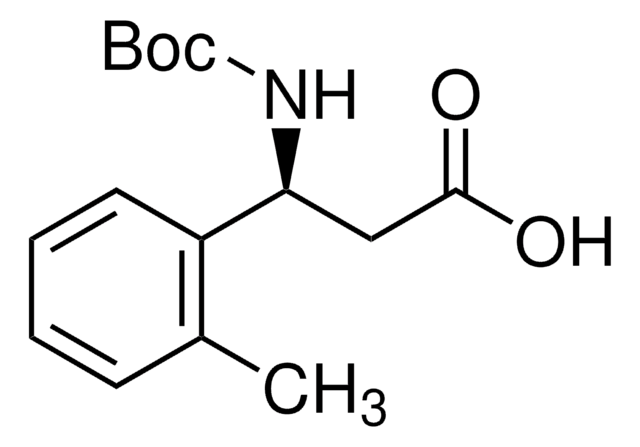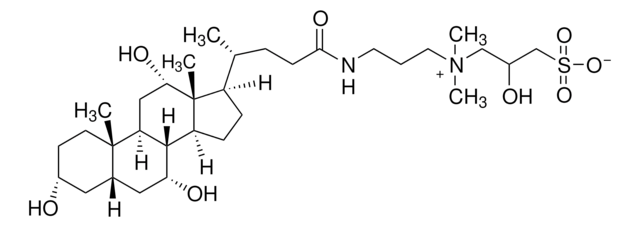19899
CHAPS 100 mM solution
Sinónimos:
CHAPS solution
About This Item
Productos recomendados
description
zwitterionic
Quality Level
form
liquid
mol wt
614.88 g/mol
concentration
100 mM in H2O
technique(s)
protein quantification: suitable
CMC
8 mM
transition temp
cloud point >100 °C
density
1.01 g/mL at 20 °C
storage temp.
2-8°C
SMILES string
C[C@H](CCC(=O)NCCC[N+](C)(C)CCCS([O-])(=O)=O)[C@H]1CC[C@H]2[C@@H]3[C@H](O)CC4C[C@H](O)CC[C@]4(C)[C@H]3C[C@H](O)[C@]12C
InChI
1S/C32H58N2O7S/c1-21(8-11-29(38)33-14-6-15-34(4,5)16-7-17-42(39,40)41)24-9-10-25-30-26(20-28(37)32(24,25)3)31(2)13-12-23(35)18-22(31)19-27(30)36/h21-28,30,35-37H,6-20H2,1-5H3,(H-,33,38,39,40,41)/t21-,22?,23-,24-,25+,26+,27-,28+,30+,31+,32-/m1/s1
InChI key
UMCMPZBLKLEWAF-RFCNGIAKSA-N
Categorías relacionadas
General description
Application
Biochem/physiol Actions
Storage Class
12 - Non Combustible Liquids
wgk_germany
WGK 3
flash_point_f
Not applicable
flash_point_c
Not applicable
ppe
Eyeshields, Gloves
Elija entre una de las versiones más recientes:
¿Ya tiene este producto?
Encuentre la documentación para los productos que ha comprado recientemente en la Biblioteca de documentos.
Nuestro equipo de científicos tiene experiencia en todas las áreas de investigación: Ciencias de la vida, Ciencia de los materiales, Síntesis química, Cromatografía, Analítica y muchas otras.
Póngase en contacto con el Servicio técnico![3-[(3-Colamidopropil)dimetilamonio]-1-propanosulfonato hydrate ≥98% (HPLC)](/deepweb/assets/sigmaaldrich/product/structures/322/134/88b00489-fbbd-47b7-ba3e-430dd6a3c852/640/88b00489-fbbd-47b7-ba3e-430dd6a3c852.png)





